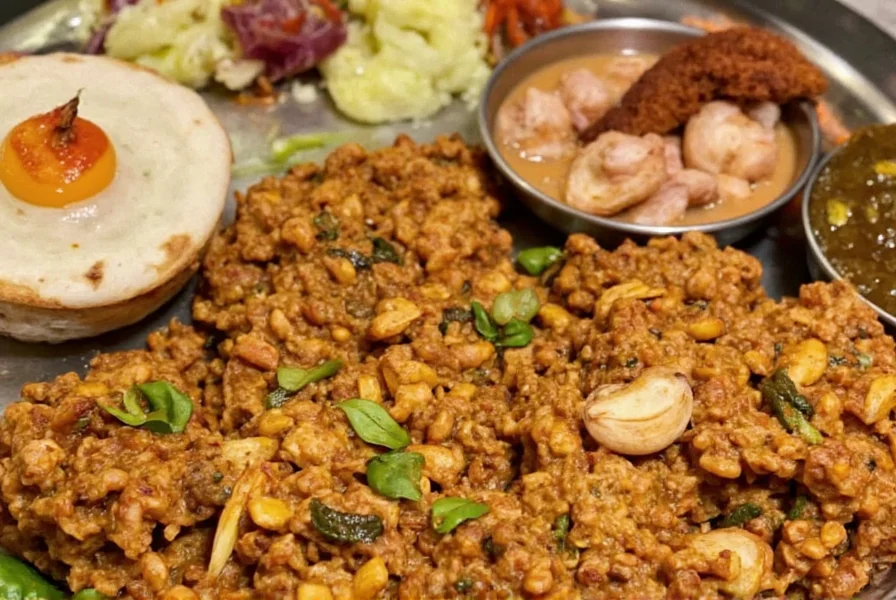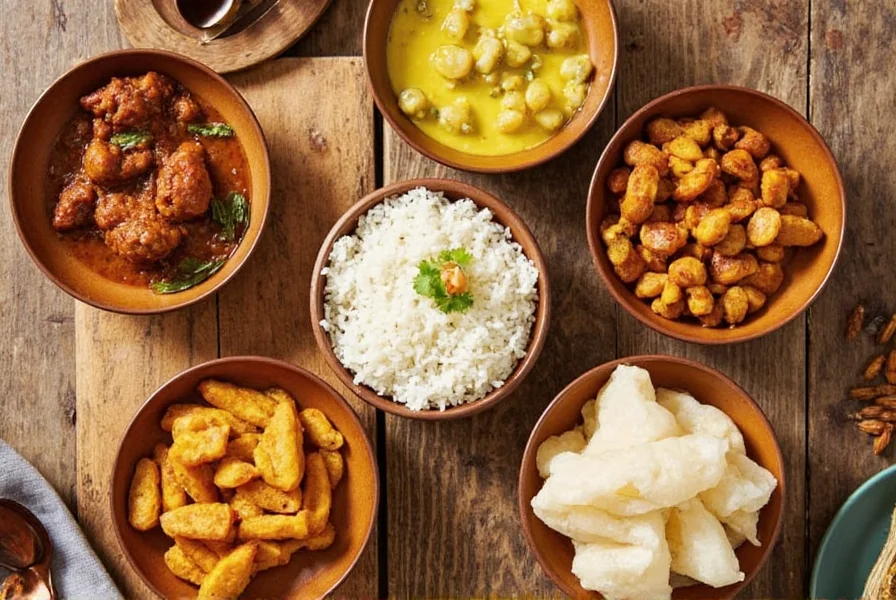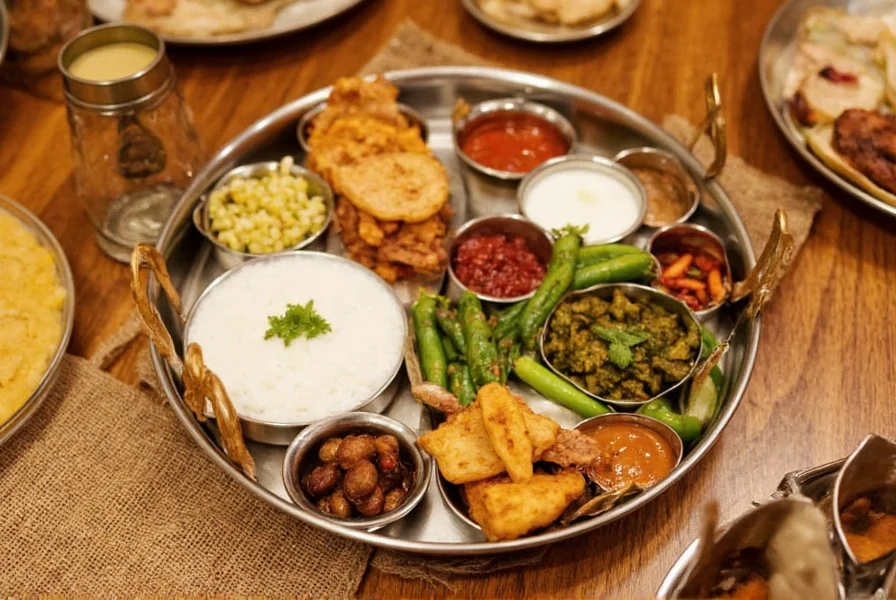Understanding the structure and diversity of Indian meals reveals why this cuisine has sustained popularity for centuries. Unlike Western meal formats, traditional Indian dining follows a holistic approach where multiple components work together to create a complete sensory and nutritional experience. The classic thali system—featuring small portions of various dishes arranged on a single platter—embodies this philosophy of balance and variety.
The Fundamental Structure of Traditional Indian Meals
Every authentic Indian meal follows a deliberate composition that ensures nutritional completeness and flavor harmony. The standard components include:
- Staple carbohydrate (rice or roti/chapati)
- Protein source (dal/lentils or meat curry)
- Vegetable dish (sabzi)
- Yogurt or raita (for digestion)
- Chutney or pickle (for flavor contrast)
- Sweet dish (optional, for balance)
This structure creates what's known in Ayurveda as "sattvic" eating—meals that balance all six tastes (sweet, sour, salty, bitter, pungent, and astringent) for optimal digestion and satisfaction. The traditional Indian meal planning approach ensures you receive complete proteins through grain-legume combinations, complex carbohydrates, and diverse micronutrients from vegetables and spices.

Regional Variations Across India
India's vast geography creates remarkable diversity in meal composition. Understanding regional Indian cuisine differences helps appreciate the country's culinary richness:
| Region | Staple Carbohydrate | Signature Dishes | Distinctive Features |
|---|---|---|---|
| North India | Wheat-based breads (roti, naan) | Dal makhani, butter chicken | Creamy gravies, tandoor cooking |
| South India | Rice | Dosa, sambar, rasam | Lentil-rice combinations, coconut-based |
| East India | Rice | Machher jhol, shorshe ilish | Mustard oil, fish preparations |
| West India | Mixed (bajra, rice, wheat) | Dhokla, thepla, fish curry | Coconut, peanuts, varied vegetarian options |
These regional Indian cuisine differences reflect local agriculture, climate, and cultural influences. For example, South Indian meals feature more rice and coconut due to the tropical climate, while North Indian cuisine incorporates more dairy products from the fertile plains. When exploring authentic Indian thali components, you'll notice these regional signatures clearly distinguish one area's cuisine from another.
Essential Spices and Ingredients
The distinctive flavor profile of Indian meals comes from carefully balanced spice combinations rather than excessive heat. Key spices include:
- Turmeric - anti-inflammatory properties, golden color
- Cumin - earthy flavor, aids digestion
- Coriander - citrus notes, balances other spices
- Mustard seeds - pungent flavor, common in South India
- Asafoetida (hing) - digestive aid, umami flavor
- Garam masala - regional spice blends added at the end
Unlike common misconceptions, authentic Indian cooking emphasizes "tadka" or tempering—heating spices in oil to release essential oils before adding other ingredients. This technique maximizes flavor extraction while preserving nutritional benefits. Understanding spices used in Indian cooking reveals why these meals offer both culinary delight and health benefits.

Cultural Significance and Meal Traditions
Indian meals extend beyond nutrition to embody cultural values and social traditions. The practice of eating with hands (specifically the right hand) connects diners to their food through touch, enhancing mindfulness. Many households still follow the tradition of "anna daan" (food donation), recognizing meals as sacred.
Meals often begin with something sweet to activate digestion, followed by savory courses, and may conclude with "paan" (betel leaf preparation) to freshen breath and aid digestion. This thoughtful sequencing demonstrates the sophisticated understanding of digestive health embedded in traditional Indian meal planning.
Modern Adaptations and Health Considerations
Contemporary interpretations of Indian meals maintain traditional balance while accommodating modern lifestyles. Health-conscious adaptations include:
- Using less oil in tempering while maintaining flavor
- Incorporating ancient grains like millets alongside rice
- Increasing vegetable variety in traditional preparations
- Creating quicker versions of classic dishes for busy schedules
Research shows traditional Indian meal structures naturally align with modern nutritional guidelines, providing balanced macronutrients and abundant phytonutrients from spices. For those exploring healthy Indian meal planning, the key is preserving the fundamental structure while making mindful ingredient choices.
Practical Tips for Enjoying Authentic Indian Meals
Whether dining at an Indian restaurant or preparing meals at home, these guidelines enhance your experience:
- Start with a small portion of each component to experience the full flavor journey
- Mix components deliberately—rice with dal, vegetables with yogurt
- Allow time between courses as traditionally practiced
- Try regional specialties to appreciate India's culinary diversity
- Pair meals with traditional accompaniments like lassi or chaas
Understanding these elements transforms Indian meals from mere sustenance to a complete cultural and sensory experience. The enduring appeal of Indian cuisine lies in this thoughtful integration of flavor, nutrition, and tradition.
Frequently Asked Questions
What makes a meal traditionally Indian?
A traditionally Indian meal features a balanced combination of rice or bread, lentils, vegetables, yogurt, and chutney arranged in a thali format. The meal follows regional culinary traditions with specific spice combinations and cooking techniques that vary across India's diverse regions. Authentic Indian meal structure emphasizes complementary proteins, complex carbohydrates, and the six tastes described in Ayurveda for complete nutrition and sensory satisfaction.
How do North Indian and South Indian meals differ?
North Indian meals typically feature wheat-based breads like roti and naan with creamy, dairy-rich gravies, while South Indian meals center around rice with lentil-based dishes like sambar and rasam. North Indian cuisine uses more dairy products and ghee, with tandoor cooking methods, whereas South Indian cuisine relies on rice-lentil combinations, coconut, and mustard oil. These regional Indian cuisine differences reflect local agricultural practices and climate conditions across India.
Are traditional Indian meals healthy?
Yes, traditional Indian meals follow a nutritionally balanced structure with complementary proteins from grain-legume combinations, complex carbohydrates, and diverse micronutrients from vegetables and spices. The use of turmeric, cumin, and other spices provides anti-inflammatory and digestive benefits. Healthy Indian meal planning maintains this traditional balance while making mindful adjustments for modern dietary needs, preserving the cuisine's inherent nutritional wisdom.
What are common vegetarian options in Indian meals?
Indian cuisine offers abundant vegetarian meal options including dal (lentil dishes), various vegetable sabzis, paneer preparations, and legume-based dishes. Many regional cuisines like Gujarati and Rajasthani are predominantly vegetarian. Indian vegetarian meal options typically combine grains and legumes to create complete proteins, making them nutritionally balanced. Dishes like chana masala, aloo gobi, and dal tadka provide satisfying protein sources without meat.











 浙公网安备
33010002000092号
浙公网安备
33010002000092号 浙B2-20120091-4
浙B2-20120091-4